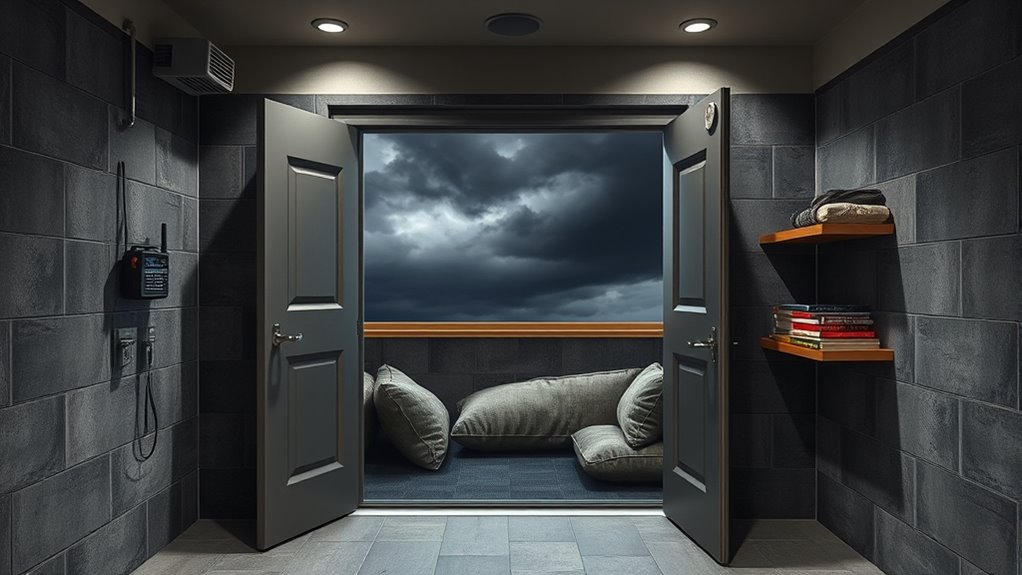To prepare for tornadoes, choose a safe room or shelter area in your home, like a basement or interior room on the lowest floor away from windows. Reinforce this space if possible, secure heavy furniture, and keep emergency supplies nearby. Make certain everyone knows how to access the shelter quickly and practice safety drills regularly. Staying informed with weather alerts and having a solid plan can keep your family safe; learn more to enhance your readiness.
Key Takeaways
- Select a small, windowless interior room on the lowest floor as a safe shelter area.
- Reinforce the safe room with sturdy materials and secure heavy furniture to prevent injuries.
- Keep emergency supplies, including water, food, flashlight, and first aid kit, readily accessible inside the safe room.
- Familiarize all family members with tornado warning procedures and safe room access through regular drills.
- Install alert systems like weather radios or smartphone apps to receive real-time tornado warnings and updates.

Have you ever wondered how to stay safe when a tornado strikes? Knowing what to do before, during, and after a tornado can make all the difference. One of the most critical steps is understanding tornado warning procedures. When a tornado warning is issued, it means a tornado has been sighted or indicated by radar in your area. You need to act quickly. Move immediately to your designated safe room or shelter area. If you don’t have a basement, choose an interior room on the lowest floor, away from windows and exterior walls. Make sure your family knows these procedures ahead of time so everyone reacts swiftly.
Preparing a safe room or shelter isn’t just about location; it’s about being ready when seconds count. Your safe room should be a space that’s easy to access during severe weather. Reinforce it if possible, and secure heavy furniture or objects that could become projectiles. Keep your emergency kit essentials in or near this room. Your kit should include bottled water, non-perishable food, a flashlight with extra batteries, a first aid kit, and necessary medications. Also, include important documents, a battery-powered radio, and a whistle to signal for help if needed. Having these essentials accessible ensures you can sustain yourself comfortably and respond effectively during an emergency.
In addition to your personal supplies, consider installing a weather radio or a smartphone app that provides real-time alerts. These tools can give you critical updates and confirm when the threat has passed. Properly understanding your projector technology can also help in creating a comfortable viewing environment during downtime, and ensuring safety measures are maintained in your home. Regularly practicing your tornado safety plan with your family helps everyone understand their role and reduces panic during an actual event. Make sure all family members know the location of your safe room and how to get there quickly. If you have children or elderly members, plan for their needs as well, such as extra blankets or mobility aids.
Frequently Asked Questions
How Do I Identify the Safest Location in My Home for a Shelter?
You should identify the safest spot in your home by choosing an interior room on the lowest floor, away from windows. Look for areas with reinforced walls and minimal exterior walls. Protect windows with shutters or plywood to prevent debris entry. Consider structural reinforcement if needed, and make certain the space has no heavy objects that could fall. This way, you minimize risks during a tornado and stay safe.
What Materials Are Best for Building a Tornado-Safe Room?
Think of your safe room as a fortress within your home. You should use reinforced concrete for walls and floors, providing a strong barrier against debris. Steel framing adds extra resilience, ensuring the structure withstands high winds. Combine these materials with sturdy doors and secure anchoring, and you’ll create a shelter that acts like a shield, offering essential protection during a tornado. Prioritize these materials to keep you safe.
How Much Does It Typically Cost to Install a Tornado Shelter?
Installing a tornado shelter typically costs between $3,000 and $10,000, depending on size, materials, and location. You should check your insurance coverage, as some policies may help offset these costs. The installation process involves excavation, securing the shelter, and guaranteeing proper ventilation and safety features. Hiring experienced professionals ensures proper installation, giving you peace of mind during severe weather.
Can I Retrofit My Existing Basement Into a Safe Room?
Think of your basement as a blank canvas—you can definitely retrofit it into a storm shelter. With the right modifications, like reinforced walls and a secure door, you turn it into a safe room. Many homeowners successfully convert their basements into effective storm shelters, providing peace of mind. Just make certain you consult local codes and professionals to make sure your basement retrofit offers maximum safety during a tornado.
What Are the Best Practices for Emergency Communication During a Tornado?
During a tornado, you should rely on emergency alerts and communication devices like NOAA weather radios, cell phones, or emergency alert apps to stay informed. Keep these devices charged and within reach. Test your alerts regularly, and have a backup power source if possible. Make sure everyone in your household knows how to receive alerts and understands how to communicate quickly and effectively if the situation worsens.
Conclusion
Remember, staying prepared can make all the difference when a tornado strikes. Have a safe room or shelter ready, keep an emergency kit handy, and stay informed through alerts. Don’t wait for the last minute—think of it as your secret weapon, like a knight’s armor in stormy times. By taking these steps now, you’ll be ready to face nature’s fury with confidence, turning chaos into calm and ensuring your safety when it counts most.








